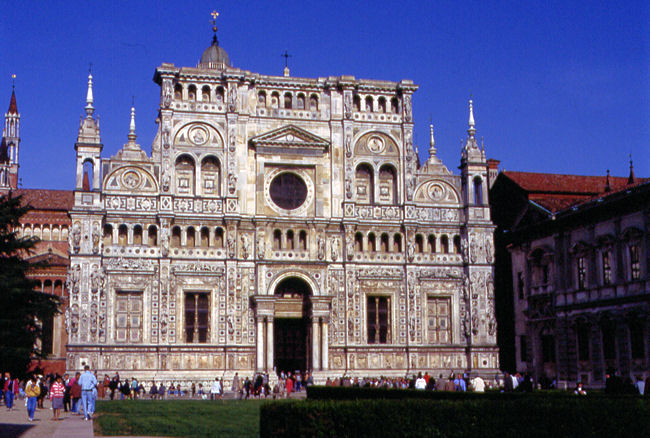|
Short history of the monastery
Carthusian monastery (1396 - 1782):
The construction contract obliged the monks to use part of the revenue of their benefice to improve the edifice so the Certosa includes a huge collection of artworks of all centuries from the 15th to the 18th.
In 1560 a printing press was installed here and all the Italian Carthusian monasteries had to get their supplies here. The first book was printed in 1561.
In 1782 the monks were expelled by the Emperor Joseph II of Austria.
Cistercencian monastery (1784 - 1798)
Instituted in 1784, the monks were expelled in 1798 by the Cisalpine Republic
Carmelite monastery (1798 - 1810)
The devastations of Napoleon’s army took place in this period: even the copper covering all the roofs was dismantled to make guns.
Closed from 1810 to 1843
Carthusian monastery (1843 - 1880)
Some monks resided there until 1880 although in 1866 it was sequestrated by the Italian State.
Restoration works before and during the First World War
Carthusian monastery (1932 - 1947):
The Certosa was spared by the air raids of Second World War. Mussolini’s body was concealed here and discovered in 1946.
In 1947 the monks left the monastery for lack of vocations.
Closed from 1947 to 1949
Carmelite monastery (1949 - 1961)
Cistercencian monastery (from 1968 to date)
The Church
The façade (completed in 1507) is enriched by 2nd half of 15th century decorations, made among others by Cristoforo Mantegazza, Giovanni Antonio Amadeo and Cristoforo Solari also known as il Gobbo (the hunchbacked). The portal (1501) is due to Benedetto Briosco.
Built on a Latin cross plan, with a nave, two aisles, transept and chancel ending with an apse, the church is covered by crossed vaults on Gothic arches; the vaults are alternatively decorated with geometrical shapes and starry skies.
The eight points star or octogram is everywhere in the nave as symbol of Our Lady of Graces and of the Certosa, together with the abbreviation Gra-Car (Gratiarum Carthusia).
The high altar (late 16th century) is decorated with bronzes, different marbles and semiprecious stones. It stands in the Sanctuary and is concealed according to the Orthodox tradition. This zone is occupied by he wooden choir with 42 stalls carved and inlaid on Bergognone’s drawings.
In the interior there are masterpieces by Bergognone, the remnant of a polyptych by Perugino and panels by Cerano, Morazzone, Guercino, Francesco Cairo and, in the sanctuary, frescoes by Daniele Crespi.
In the southern transept there is the tomb of Gian Galeazzo Visconti, begun in 1494-1497 but completed only in 1562.
The northern transept houses the tomb of Ludovico Sforza ("The Moor"), 7th Duke of Milan, and his wife Beatrice d'Este. The tombs are empty: the Moor is buried in France where he died while Beatrice d’Este is buried in the Milanese church of Santa Maria delle Grazie.
The Certosa possesses valuable stained glass windows, executed to cartoons of the 15th century
In the old Sacristy is the monumental elaborate triptych in ivory and hippopotamus' ivory by the Florentine Baldassarre di Simone di Aliotto Donated by Gian Galeazzo Visconti. The triptych was stolen in 1984 and recovered in 1985.
The small Cloister
A sculptured portal leads from the church to the small cloister, which connected the various places of the monastery and where a great part of the community life went on.
The grand cloister
It measures about 125x100 metres. At the beginning the cells of the monks opening to the central garden were 23, in 1514 increased to 36 while today are 24. The cells (actually small houses with three rooms and a little garden) are marked by the letters of the alphabet. The hole next to the door was used to provide the meal in the weekdays, since the monks took a community meal (in silence) in the refectory only on Sunday and in feast days. According to the rule the monks had to live in solitude and silence but had to execute some duty (the “obedience”) for the common good of the community.
The arcades have columns alternatively in white and pink Verona marble with precious decorations in terracotta.
The New Sacristy, former Chapter House, contains a cycle of frescoes by the Sorri brothers, (late Senese Mannerism), .paintings by Francesco Cairo, Camillo Procaccini, il Passignano and Giulio Cesare Procaccini; the altarpiece begun in 1524 by Andrea Solario, was completed fifty years later by Bernardino Campi.
The refectory has a fresco with the Last Supper by Ottavio Semino (1567) and, in the vault, a Madonna with Child and Prophets by Bergognone.
In the Foresteria (Guest Room) or Palazzo Ducale, built in the 17th century by Francesco Maria Richino, are frescoes and paintings by Vincenzo and Bernardino Campi, Bartolomeo Montagna, Bergognone and Bernardino Luini.
The collection of plaster casts exhibits copies of several sculptures belonged to the Visconti |




































